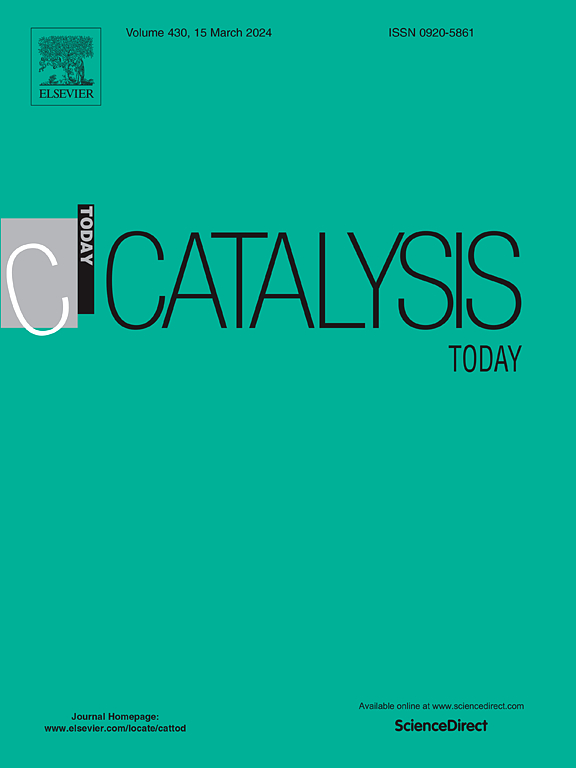在Sn(IV)催化剂存在下合成乙酰丙酸甘油:催化剂性质和反应参数的评价
IF 5.2
2区 化学
Q1 CHEMISTRY, APPLIED
引用次数: 0
摘要
本研究首次研究了以Sn(IV)为催化剂的一系列配合物:二氯化二丁基锡(Bu2SnCl2)、二氯化二甲基锡(Me2SnCl2)、三氯化丁基锡(BuSnCl3)、三氯化甲基锡(MeSnCl3)、丁酸(BuSnO(OH))、氧化二丁基锡(Bu2SnO)和二酸二丁基锡(Bu2SnLau2)催化乙酰丙酸(LA)与甘油(GLY)的酯化反应。考察了催化剂性质和负载、反应时间、反应物比例、温度等条件对反应性能的影响。最活跃的Sn(IV)配合物(BuSnCl3;kap = 52岁8 ×10−3分钟−1)导致了g转换∼74 % 15 在第一分钟和97∼360年 % min,形成共26.5 % GML 56.0 % GDL和14.0 % GTL(360 分钟,100°C;摩尔比LA:GLI:CAT为4:1:0.01)。根据在不同温度下测定的表观速率常数(kap),可以估计出GLY转化的活化能(AE),在有BuSnCl3的情况下为12.5 kJ mol−1,在没有催化剂的情况下为24 kJ mol−1,表明AE降低了约50% %。与使用传统的Bronsted酸催化剂(盐酸(HCl)和对甲苯磺酸(p-TsOH))进行的反应相比,这一吉祥的结果显示了基于Sn(IV)的体系的潜力,而没有使用上述酸相关的缺点,例如反应器腐蚀等。本文章由计算机程序翻译,如有差异,请以英文原文为准。

Synthesis of glycerol levulinates in the presence of Sn(IV) catalysts: Evaluation of the catalyst nature and reactional parameters
This study investigated, for the first time, the use of a series of complexes based on Sn(IV) as catalysts in the esterification of levulinic acid (LA) with glycerol (GLY): dibutyltin dichloride (Bu2SnCl2), dimethyltin dichloride (Me2SnCl2), butyltin trichloride (BuSnCl3), methyltin trichloride (MeSnCl3), butylstanic acid (BuSnO(OH)), di-n-butyltin oxide (Bu2SnO) and dibutyltin dilaurate (Bu2SnLau2). The influences of various reaction conditions, including catalyst nature and loading, reaction time, proportion of reactants, and temperature, were investigated. The most active Sn(IV) complex (BuSnCl3; kap = 52,8 × 10−3 min−1) led to a GLY conversion of ∼ 74 % in the first 15 min and ∼ 97 % in 360 min, with a total formation of 26.5 % GML, 56.0 % GDL and 14.0 % GTL (360 min, 100 °C; molar ratio LA:GLI:CAT of 4:1:0.01). From the apparent rate constants (kap) determined at various temperatures, it was possible to estimate the activation energy (AE) for the GLY conversion, which was 12.5 kJ mol−1 in the presence of BuSnCl3 and 24 kJ mol−1 for the reaction performed without a catalyst, representing a decrease of approximately 50 % in the AE. This auspicious result associated with the comparison with reactions performed and using conventional Bronsted acid catalysts (hydrochloric acid (HCl) and p-toluenesulfonic acid (p-TsOH)) shows the potential of systems based on Sn(IV), without the drawbacks associated with the use of the aforementioned acids, such as reactor corrosion, among others.
求助全文
通过发布文献求助,成功后即可免费获取论文全文。
去求助
来源期刊

Catalysis Today
化学-工程:化工
CiteScore
11.50
自引率
3.80%
发文量
573
审稿时长
2.9 months
期刊介绍:
Catalysis Today focuses on the rapid publication of original invited papers devoted to currently important topics in catalysis and related subjects. The journal only publishes special issues (Proposing a Catalysis Today Special Issue), each of which is supervised by Guest Editors who recruit individual papers and oversee the peer review process. Catalysis Today offers researchers in the field of catalysis in-depth overviews of topical issues.
Both fundamental and applied aspects of catalysis are covered. Subjects such as catalysis of immobilized organometallic and biocatalytic systems are welcome. Subjects related to catalysis such as experimental techniques, adsorption, process technology, synthesis, in situ characterization, computational, theoretical modeling, imaging and others are included if there is a clear relationship to catalysis.
 求助内容:
求助内容: 应助结果提醒方式:
应助结果提醒方式:


